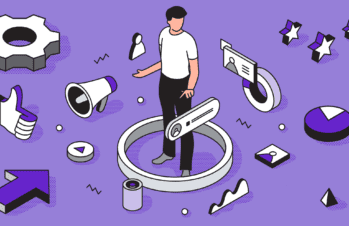Arguably the most crucial component of successful marketing today is cultivating a relationship with your ideal buyers—AKA your audience.
Consumers today are in the market to be marketed to, which is why so many successful accounts on social media are creator or seller accounts that create content to trigger a touchpoint or purchasing action.
The Flywheel: A Model for Retaining Your Best Customers
There’s an increased opportunity for brands to form connections with their customers. The flywheel model is a good visualization of this because it replaces the typical sales funnel with a cycle of attracting, engaging, and delighting customers.
And it’s our opinion that the delight stage deserves extra attention because your best customers are your existing customers.
A study by SimplicityDX revealed that the cost of customer acquisition has increased by 222% percent in the last eight years. Semrush corroborates that the probability of selling to an existing customer is between 60% and 70%, whereas the probability of selling to a new customer is only between 5% and 20% (ouch).
Based on this data, we did a little math (OK, it was ChatGPT), and found that it is 160% harder to acquire a new customer than to sell to a new customer.
In other words, you have to put the time into delighting the customers who have already bought from your company. It’s not only essential to your revenue stream, but it’s also one of the most efficient ways to drive more business.
Repetition Drives Revenue: The Power of Continued Exposure
Post-purchase marketing isn’t an ancillary strategy, it’s the ketchup to the French fries: it’s a must-have.
Marketing is indeed responsible for initially targeting and capturing audiences, and then converting them to customers, but it’s also responsible for customers’ perception of your brand throughout their relationship with you.
On the Dot Loves Marketing podcast, CEO and founder of Zen Media, Shama Hyder, drilled down on this idea, emphasizing that “repetition drives revenue.” Continued exposure to a brand results in an increased likelihood of purchase, and brands should be wise enough to target not only new customers but repeat customers as well.
RAIN Group shares that it takes up to eight touchpoints to convert a contact from prospect to customer. Are the 7 points of interaction up until the sale in vain? On the contrary, they are the actions that guide prospects to purchase. Exposure is currency. This goes for the post-purchase phase as well.
Benchmarking Against Tech Giants: The Amazon Effect
There are an abundance of reasons to provide customers with a post-purchase experience.
For one, businesses are inherently competing with the mogul tech companies of the world. Amazon provides a “your order has shipped,” and “it’s on its way,” point of contact, which provides customers with a sense of trust and security. Customers can very well order items from Amazon on millions of other websites that exist on the internet, but those other companies fail to provide customers with reliability and predictability. When Amazon sets the standard, smaller-to-mid-sized companies can follow suit in customer experience, to the best of their ability. Doing so drives revenue.
Post-purchase Marketing in Action: Melinda and the Body Scrub Emporium
Let’s say there is a woman named Melinda, who orders a body scrub from an e-commerce website. Afterward, she begins to question the purchase. She thinks about the trade-offs, the few cups of coffee or new t-shirts that she could have purchased instead of the body scrub.
But then the Body Scrub Emporium sends her an SMS, informing Melinda that this body scrub contains caffeine to keep her skin perky all day, and antioxidants that support immune health.
The Body Scrub Emporium is using post-purchase marketing to alleviate her doubt and prime Melinda to anticipate the product’s arrival, as well as its overall benefits. This then encourages her to use the body scrub for at least a week to see results, and by the time she is sold on having bought the product, she gets another email from the Body Scrub Emporium. There’s an offer for a caffeine-containing eye-roller and an antioxidant hand cream. You guessed it: Melinda wants it all.
The Body Scrub Emporium has captured her trust and attention by cross-selling products that appeal to Melinda, turning her pain points—concerns about dull skin and aging—into pleasure points with their products.
Companies can be like the fictional Body Scrub Emporium and introduce complementary products or services to their customer bases, encouraging additional purchases based on initial buy-in.
Not only is it a winning market strategy, but it’s something that customers want. Business Wire reports that 75% of consumers today expect retailers to suggest new products based on their interactions. In the same article, they cite that 82% are incentivized to make another purchase with the same brand when offered coupons, discounts, or enrollment into a loyalty program (hello community!).
Key Components for Post-purchase Marketing Success
Post-purchase marketing doesn’t require a brand-new strategy, but rather the introduction of a few key components. One game-changer would be recommendation software that uses data science to dynamically recommend relevant products to buyers. For small businesses this might be a tall order, but it could go a long way.
Tailored Content
Tailored content specifically for your current customers is also highly effective. This includes content such as how-to guides (for purchased products and related items), maintenance tips, and product deep dives (from e-books to TikToks). The point is to engage customers past the point of sale so that they are primed to buy from you again.
Following Up
Engaging in follow-ups—sending out surveys, thank you emails, or free product samples or gifts, for example—is also beneficial.
Even if your business doesn’t see a high survey fill-out rate, showing that your company truly cares about the customer experience will help build trust. In addition, proactively giving customers the option to report any dissatisfaction can help reduce their frustration right from the beginning.
The best follow-up campaigns will emerge when your marketing team works collaboratively with your customer service department since it’s your customer service reps who are responding to customer concerns and hearing from them regularly.
Community is Where Relationships are Born and Strengthened
Let’s take a look at one great example of follow-up marketing: Nike Run Club.
Nike Run Club is an application and community in which users can set goals and meet them together. The app can be downloaded upon purchase of a pair of Nike shoes, and it includes both physical and digital components like challenges, statistics, track running tips, and wellness ideas. In an interview, Adam Sussman, then Chief Digital Officer of Nike, noted 100 million members in their Nike Plus program. They also host an NRC 5K community run, which includes a Q&A with a Nike elite athlete, activities, and refreshments. NRC is the number one run club and guides almost 50 million miles of running each month.
Communities like this are the future, and the future is here. Funneling users into a community post-purchase welcomes them into a cultivated ecosystem of people with shared interests, where members can connect through relevant content and events. Brands should look into communities because they are a breeding ground for ideas. All the target buyers (who’ve already bought) are in one space, having discussions with one another and sharing their feedback and desires—that is gold, for them and the business. Communities are the age-old way to build powerful, trusting relationships in which people (face it, buyers) keep coming back.
If your brand needs some post-purchase marketing support, we can help.







